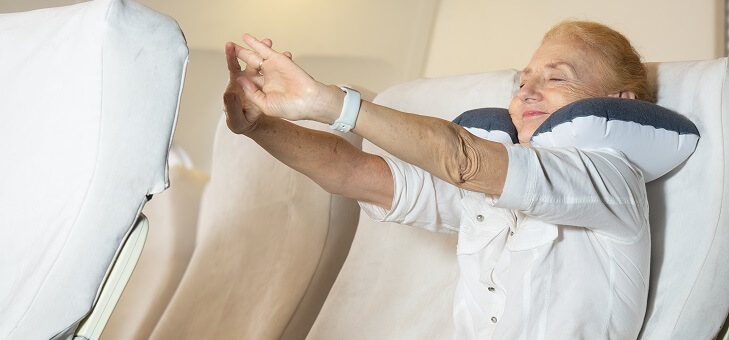For many of us, long flights are simply a necessary evil. We may not enjoy the experience, but it’s the only way to get to our desired destination. Upon landing, we often feel stiff and sore from sitting in an uncomfortable seat for hours on end. This is one of the biggest issues with long-haul flights, our bodies are not designed to be in one position for such a long period of time.
It’s not just about being uncomfortable – sitting for prolonged periods of time on a flight can wreak havoc on your body. It can lead to joint stiffness, muscle tightness, fluid stagnation and issues with your digestion, metabolism, fatigue and dehydration.
Here are a few things to keep in mind if you want to avoid aches and pains on a flight.
Keep moving
It’s important to get up and keep moving whether you need the toilet or not. It’s recommended that you get up to move around every hour to stretch your legs and decompress the spine a bit.
The aisles are typically quite tight but standing in place exercises can be carried out without disturbing the people around you.
Calf raises activate the calf muscles to help use them as a pump to aid blood flow back to the heart. Standing backbends help to reverse the curve in the lower back and stretch the front of the hips open.
If you’re standing in line for the loo, do a few squats and standing yoga poses such as gentle twists and bends to get your blood flowing. If you feel a bit silly, you could always ask a flight attendant if it’s OK. It’s very unlikely they’ll say no. And you never know, you might inspire some other passengers to get moving.
Read: How to fly with back pain problems
Exercise while sitting
Try to avoid sitting in the same position for the whole flight. Instead, move positions frequently, and try to stretch within your limited space. Movement and muscle activation help to reduce aches and pains from sitting for too long.
Try some ankle pumps, knee straightening and knee lifts. Glute squeezes are also easy and can help activate the hip muscles, which are often in an overstretched position when sitting.
Try to do the more distracting movements before the lights go off and your seatmate settles down to try to get some rest. But any type of lower body movement and muscle contraction will help avoid fluid in the lower extremities from stagnating. Even waving the toes and making a ‘fist’ with your toes and then fully straightening them several times will stimulate blood flow to and from the feet.
Don’t forget to move your neck too, roll and stretch it in all directions slowly, in control and while seated.
Read: How to cope with swollen ankles on holiday
Stay hydrated
One of the best things you can do for your body on inflight is to keep up your fluids. There’s no easier place to dehydrate and cramp your muscles than on an airplane.
Avoid alcohol and other tempting drinks often on offer and stick with water. Airplane food is often high in salt so drink as much water as you can to avoid dehydration.
Don’t forget about the rest of your body either. Make sure you pack a good moisturiser, hand cream and lip balm in your carry-on bag and use them regularly. Your skin and lips will thank you for it.
Try to get some rest
Sleeping in an upright seat can be tricky, especially when experts tell you not to torque the spine, cross the legs or bend the joints into the extreme ranges of motion. Getting comfortable without compressing the tissues, restricting blood flow or kinking the spinal column can be hard, but the best sleeping position on a plane is a neutral one.
Rolling a scarf or jumper and placing it along your lower back can help keep the spinal column in the best position to reduce stress on the intervertebral discs and lower back muscles.
Use a neck pillow or a moveable headrest to support the head in a neutral, but relaxed, position.
Read: How flying affects your body
Keep up the good habits after the flight
To avoid being sore before your holiday really starts, do some mobility exercises such as cat/cow pose or downward-facing dog to help mobilise the joints as soon as you check in to your hotel.
If possible, do some light cardio and weights to help to pump fluid throughout the body and tighten up the muscles and soft tissues.
If you enjoy our content, don’t keep it to yourself. Share our free eNews with your friends and encourage them to sign up.

